Chemical Engineering Project: Shell and Tube Heat Exchanger - CE 1.1
VerifiedAdded on 2020/04/21
|12
|1792
|118
Project
AI Summary
This project report, prepared by a chemical engineering student, focuses on the design and analysis of a shell and tube heat exchanger. The report begins with an introduction to the project, outlining its objectives, the student's role as a team member, and the project's background, including the characteristics and classification of heat exchangers. The student's responsibilities encompassed understanding design principles, demonstrating thermal design basics, classifying heat exchangers based on applications, identifying thermal design considerations, and illustrating the design procedure using trial-and-error calculations. The report delves into the theory of heat transfer, the types of shell and tube exchangers, and the engineering knowledge and skills applied, including thermal design considerations and fouling factors. It also covers the student's accomplishments, the identified issues and solutions, and collaborative work. The project review provides an overview of the design process, the student's contribution, and highlights the importance of understanding heat transfer principles in chemical engineering applications.

Akhilesh Udeniyan
Career Episode 1
Competency Demonstration Report (CDR)
Career Episode 1
Competency Demonstration Report (CDR)
Paraphrase This Document
Need a fresh take? Get an instant paraphrase of this document with our AI Paraphraser
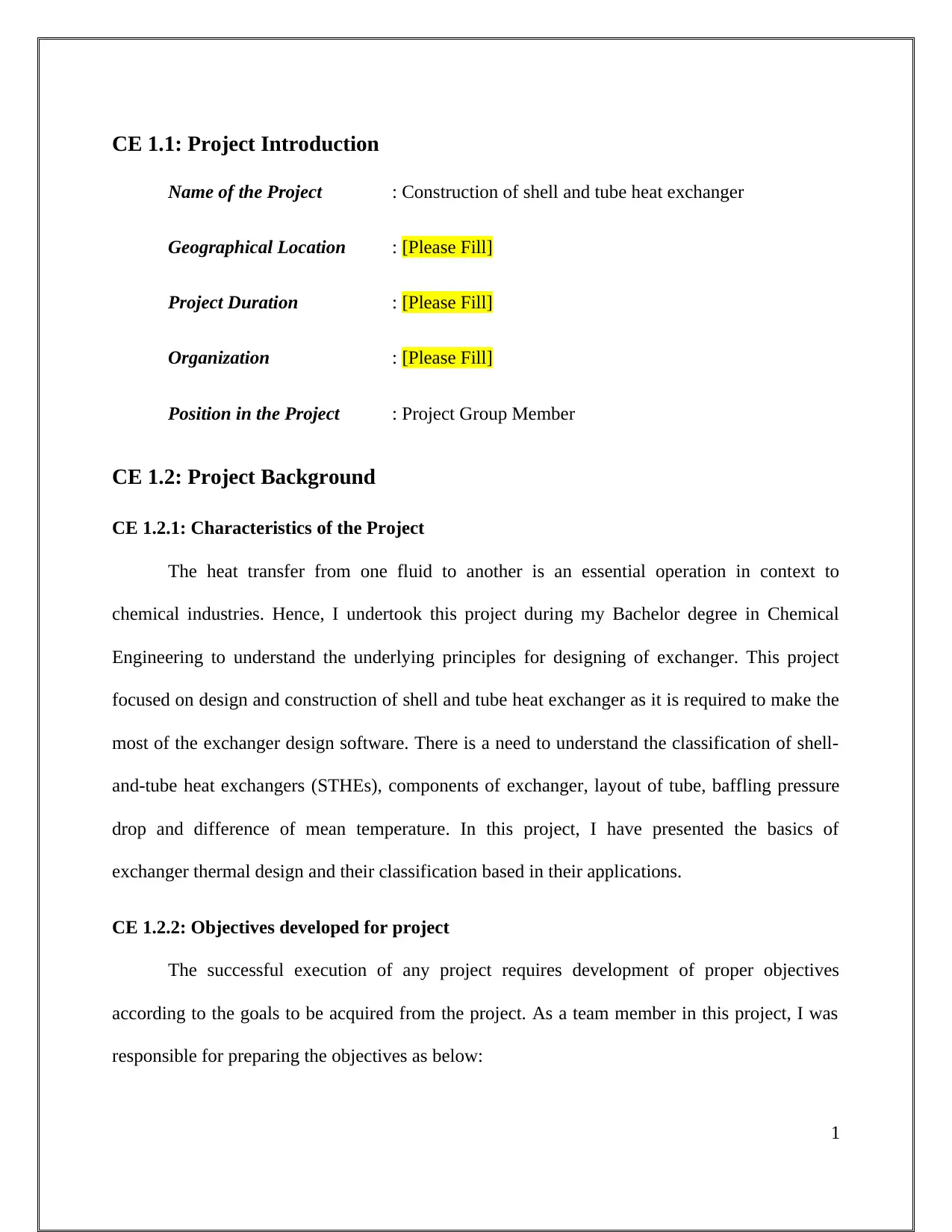
CE 1.1: Project Introduction
Name of the Project : Construction of shell and tube heat exchanger
Geographical Location : [Please Fill]
Project Duration : [Please Fill]
Organization : [Please Fill]
Position in the Project : Project Group Member
CE 1.2: Project Background
CE 1.2.1: Characteristics of the Project
The heat transfer from one fluid to another is an essential operation in context to
chemical industries. Hence, I undertook this project during my Bachelor degree in Chemical
Engineering to understand the underlying principles for designing of exchanger. This project
focused on design and construction of shell and tube heat exchanger as it is required to make the
most of the exchanger design software. There is a need to understand the classification of shell-
and-tube heat exchangers (STHEs), components of exchanger, layout of tube, baffling pressure
drop and difference of mean temperature. In this project, I have presented the basics of
exchanger thermal design and their classification based in their applications.
CE 1.2.2: Objectives developed for project
The successful execution of any project requires development of proper objectives
according to the goals to be acquired from the project. As a team member in this project, I was
responsible for preparing the objectives as below:
1
Name of the Project : Construction of shell and tube heat exchanger
Geographical Location : [Please Fill]
Project Duration : [Please Fill]
Organization : [Please Fill]
Position in the Project : Project Group Member
CE 1.2: Project Background
CE 1.2.1: Characteristics of the Project
The heat transfer from one fluid to another is an essential operation in context to
chemical industries. Hence, I undertook this project during my Bachelor degree in Chemical
Engineering to understand the underlying principles for designing of exchanger. This project
focused on design and construction of shell and tube heat exchanger as it is required to make the
most of the exchanger design software. There is a need to understand the classification of shell-
and-tube heat exchangers (STHEs), components of exchanger, layout of tube, baffling pressure
drop and difference of mean temperature. In this project, I have presented the basics of
exchanger thermal design and their classification based in their applications.
CE 1.2.2: Objectives developed for project
The successful execution of any project requires development of proper objectives
according to the goals to be acquired from the project. As a team member in this project, I was
responsible for preparing the objectives as below:
1
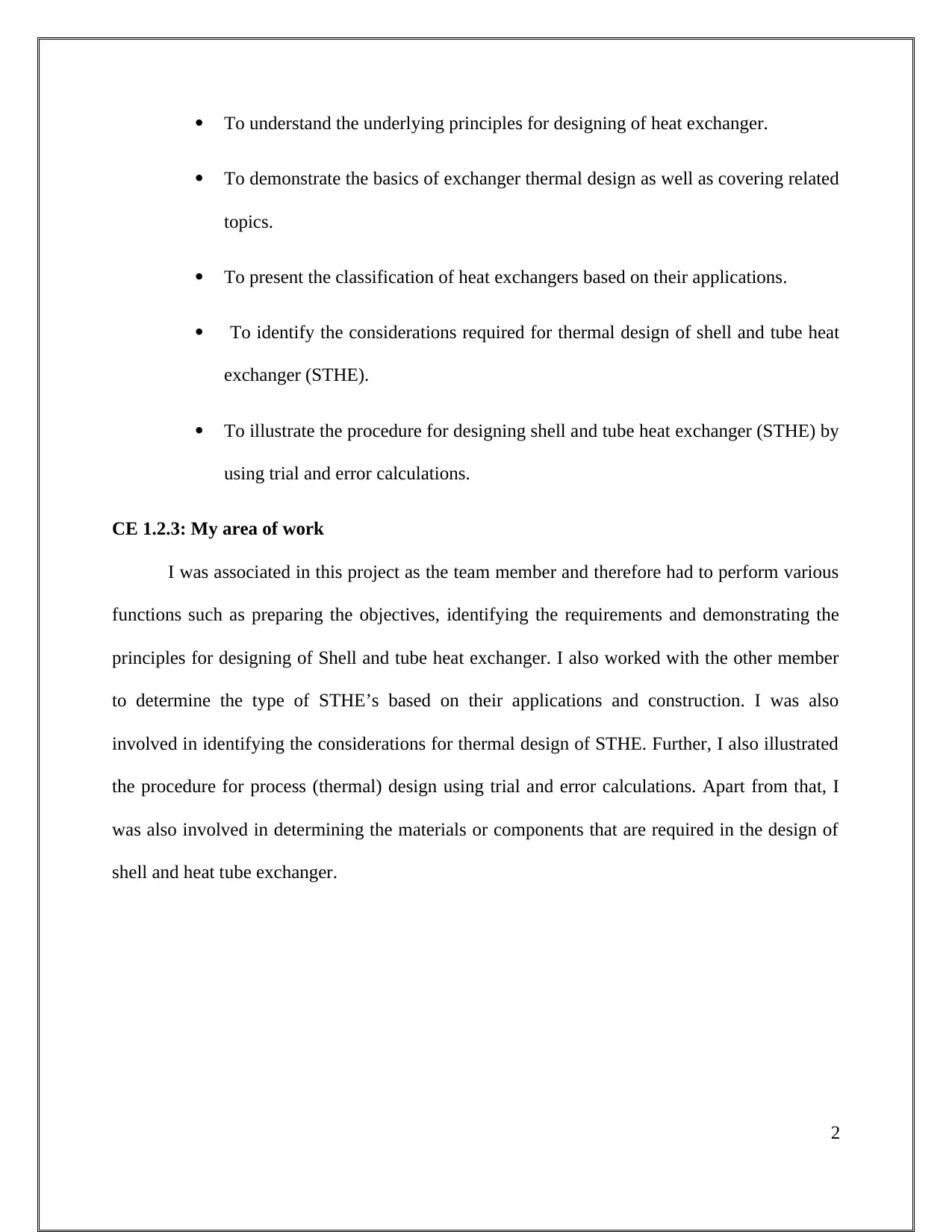
To understand the underlying principles for designing of heat exchanger.
To demonstrate the basics of exchanger thermal design as well as covering related
topics.
To present the classification of heat exchangers based on their applications.
To identify the considerations required for thermal design of shell and tube heat
exchanger (STHE).
To illustrate the procedure for designing shell and tube heat exchanger (STHE) by
using trial and error calculations.
CE 1.2.3: My area of work
I was associated in this project as the team member and therefore had to perform various
functions such as preparing the objectives, identifying the requirements and demonstrating the
principles for designing of Shell and tube heat exchanger. I also worked with the other member
to determine the type of STHE’s based on their applications and construction. I was also
involved in identifying the considerations for thermal design of STHE. Further, I also illustrated
the procedure for process (thermal) design using trial and error calculations. Apart from that, I
was also involved in determining the materials or components that are required in the design of
shell and heat tube exchanger.
2
To demonstrate the basics of exchanger thermal design as well as covering related
topics.
To present the classification of heat exchangers based on their applications.
To identify the considerations required for thermal design of shell and tube heat
exchanger (STHE).
To illustrate the procedure for designing shell and tube heat exchanger (STHE) by
using trial and error calculations.
CE 1.2.3: My area of work
I was associated in this project as the team member and therefore had to perform various
functions such as preparing the objectives, identifying the requirements and demonstrating the
principles for designing of Shell and tube heat exchanger. I also worked with the other member
to determine the type of STHE’s based on their applications and construction. I was also
involved in identifying the considerations for thermal design of STHE. Further, I also illustrated
the procedure for process (thermal) design using trial and error calculations. Apart from that, I
was also involved in determining the materials or components that are required in the design of
shell and heat tube exchanger.
2
⊘ This is a preview!⊘
Do you want full access?
Subscribe today to unlock all pages.

Trusted by 1+ million students worldwide
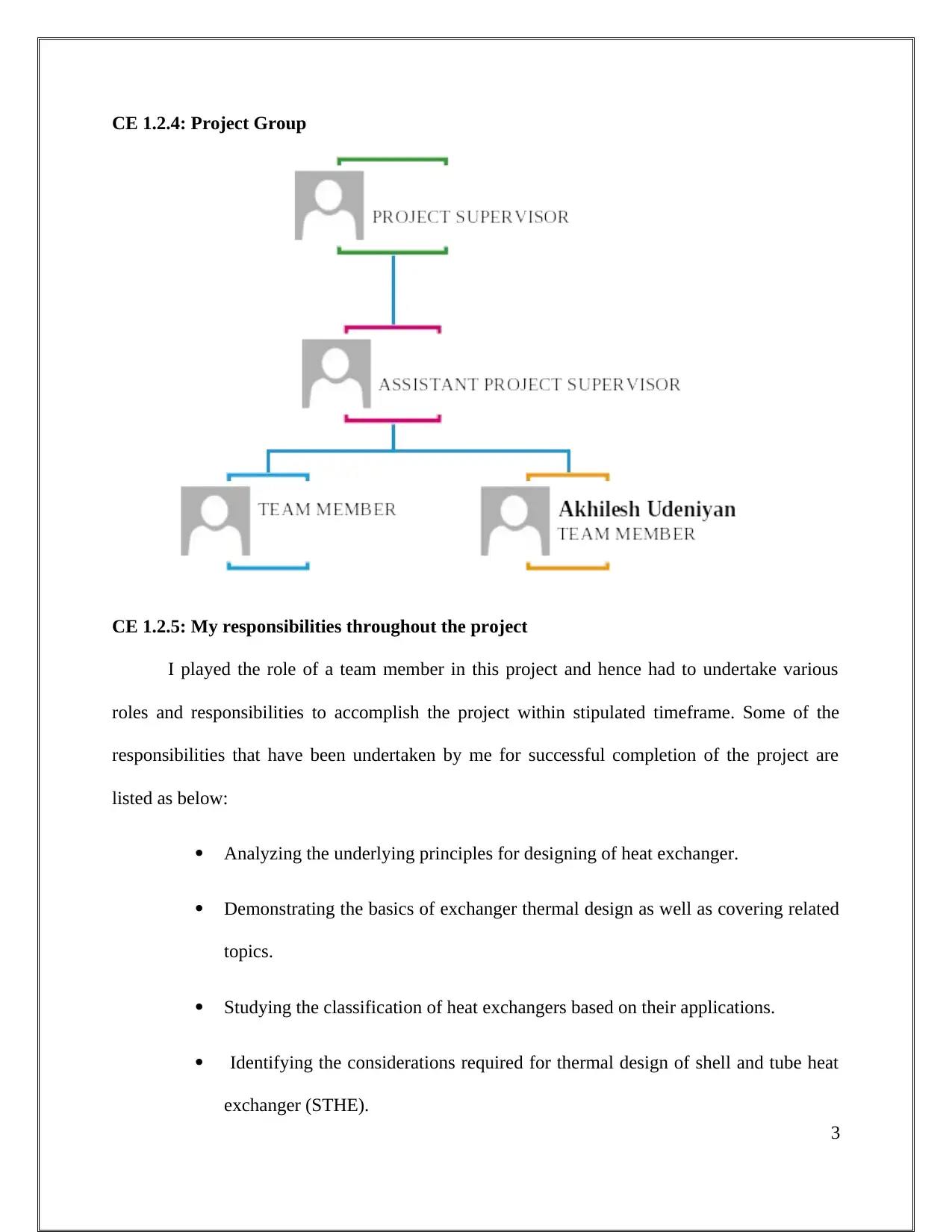
CE 1.2.4: Project Group
CE 1.2.5: My responsibilities throughout the project
I played the role of a team member in this project and hence had to undertake various
roles and responsibilities to accomplish the project within stipulated timeframe. Some of the
responsibilities that have been undertaken by me for successful completion of the project are
listed as below:
Analyzing the underlying principles for designing of heat exchanger.
Demonstrating the basics of exchanger thermal design as well as covering related
topics.
Studying the classification of heat exchangers based on their applications.
Identifying the considerations required for thermal design of shell and tube heat
exchanger (STHE).
3
CE 1.2.5: My responsibilities throughout the project
I played the role of a team member in this project and hence had to undertake various
roles and responsibilities to accomplish the project within stipulated timeframe. Some of the
responsibilities that have been undertaken by me for successful completion of the project are
listed as below:
Analyzing the underlying principles for designing of heat exchanger.
Demonstrating the basics of exchanger thermal design as well as covering related
topics.
Studying the classification of heat exchangers based on their applications.
Identifying the considerations required for thermal design of shell and tube heat
exchanger (STHE).
3
Paraphrase This Document
Need a fresh take? Get an instant paraphrase of this document with our AI Paraphraser
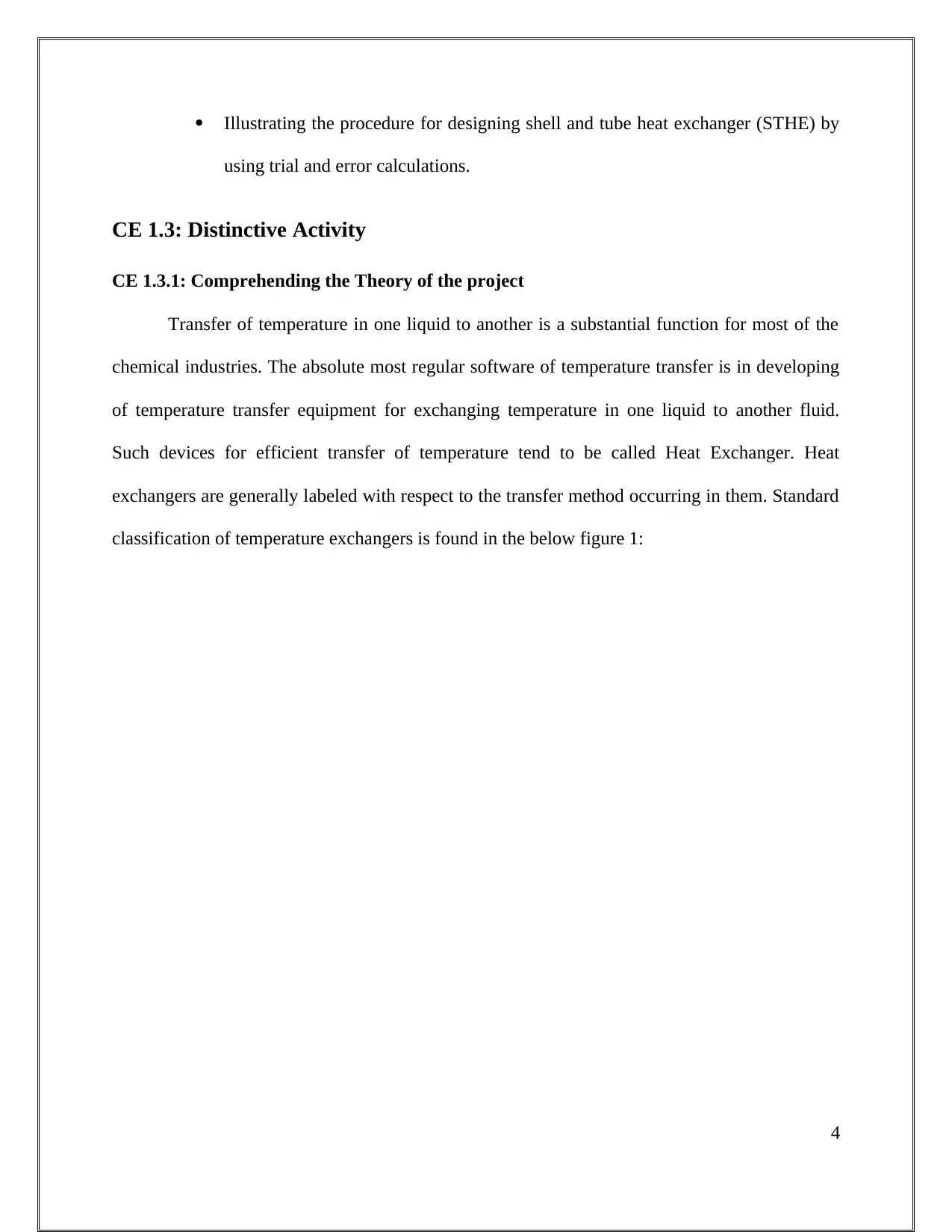
Illustrating the procedure for designing shell and tube heat exchanger (STHE) by
using trial and error calculations.
CE 1.3: Distinctive Activity
CE 1.3.1: Comprehending the Theory of the project
Transfer of temperature in one liquid to another is a substantial function for most of the
chemical industries. The absolute most regular software of temperature transfer is in developing
of temperature transfer equipment for exchanging temperature in one liquid to another fluid.
Such devices for efficient transfer of temperature tend to be called Heat Exchanger. Heat
exchangers are generally labeled with respect to the transfer method occurring in them. Standard
classification of temperature exchangers is found in the below figure 1:
4
using trial and error calculations.
CE 1.3: Distinctive Activity
CE 1.3.1: Comprehending the Theory of the project
Transfer of temperature in one liquid to another is a substantial function for most of the
chemical industries. The absolute most regular software of temperature transfer is in developing
of temperature transfer equipment for exchanging temperature in one liquid to another fluid.
Such devices for efficient transfer of temperature tend to be called Heat Exchanger. Heat
exchangers are generally labeled with respect to the transfer method occurring in them. Standard
classification of temperature exchangers is found in the below figure 1:
4
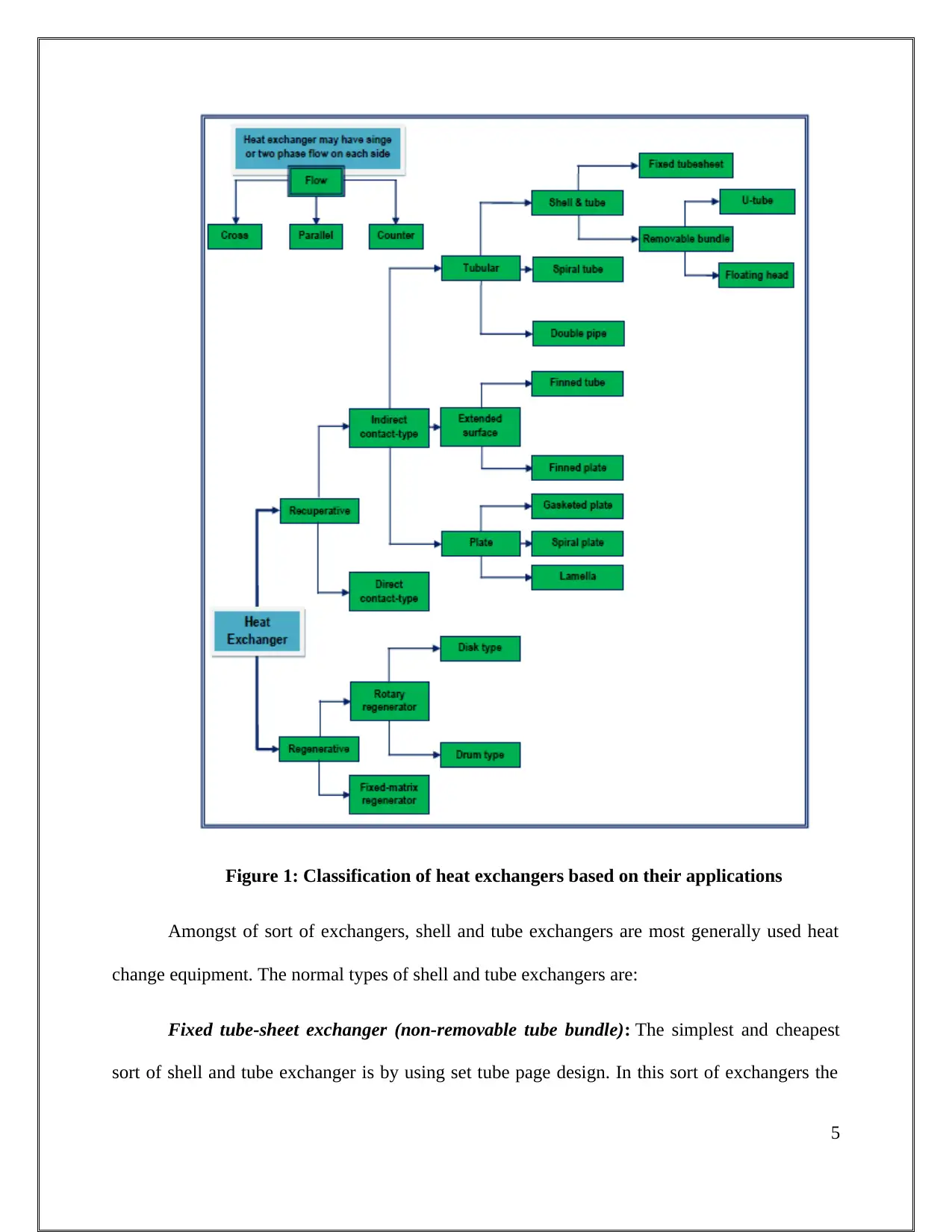
Figure 1: Classification of heat exchangers based on their applications
Amongst of sort of exchangers, shell and tube exchangers are most generally used heat
change equipment. The normal types of shell and tube exchangers are:
Fixed tube-sheet exchanger (non-removable tube bundle): The simplest and cheapest
sort of shell and tube exchanger is by using set tube page design. In this sort of exchangers the
5
Amongst of sort of exchangers, shell and tube exchangers are most generally used heat
change equipment. The normal types of shell and tube exchangers are:
Fixed tube-sheet exchanger (non-removable tube bundle): The simplest and cheapest
sort of shell and tube exchanger is by using set tube page design. In this sort of exchangers the
5
⊘ This is a preview!⊘
Do you want full access?
Subscribe today to unlock all pages.

Trusted by 1+ million students worldwide
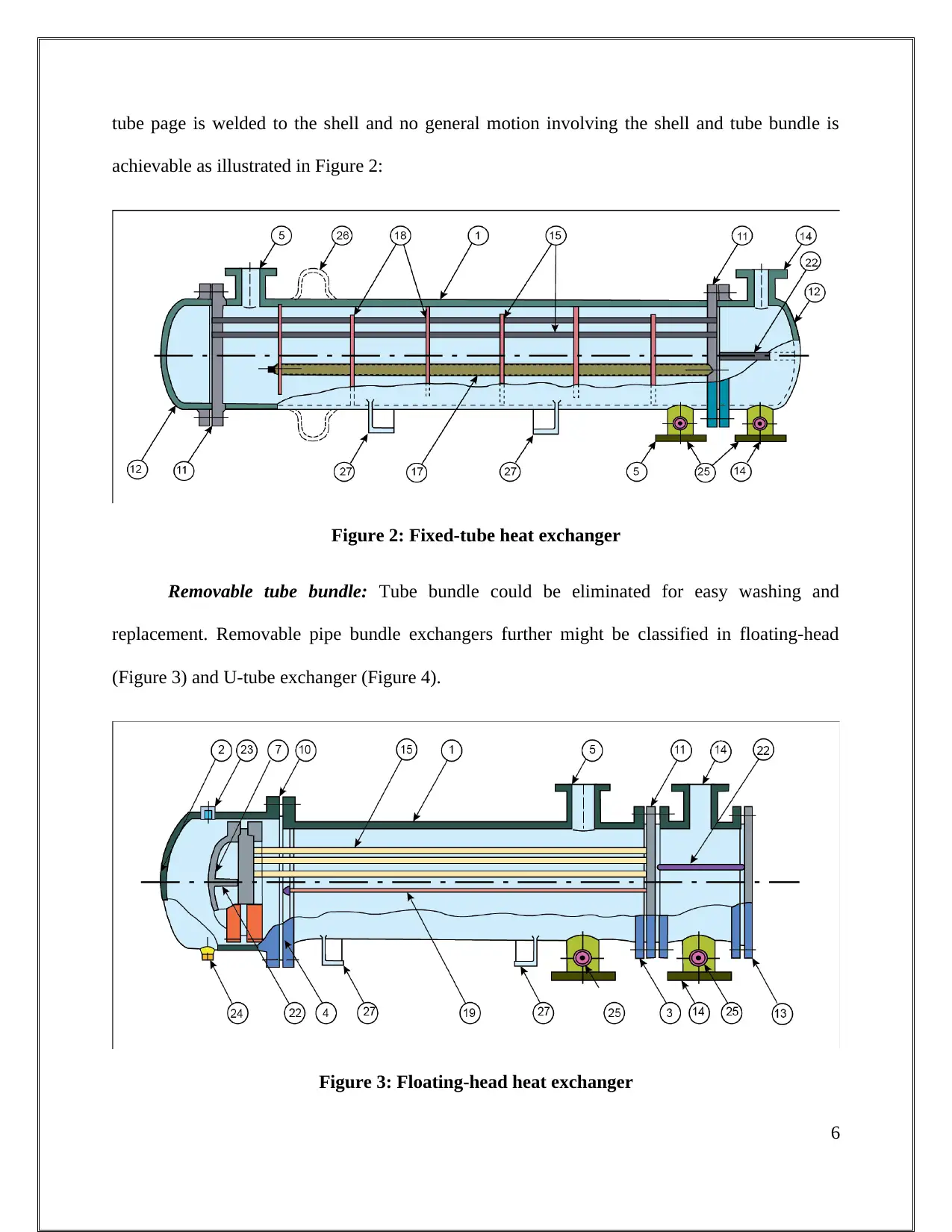
tube page is welded to the shell and no general motion involving the shell and tube bundle is
achievable as illustrated in Figure 2:
Figure 2: Fixed-tube heat exchanger
Removable tube bundle: Tube bundle could be eliminated for easy washing and
replacement. Removable pipe bundle exchangers further might be classified in floating-head
(Figure 3) and U-tube exchanger (Figure 4).
Figure 3: Floating-head heat exchanger
6
achievable as illustrated in Figure 2:
Figure 2: Fixed-tube heat exchanger
Removable tube bundle: Tube bundle could be eliminated for easy washing and
replacement. Removable pipe bundle exchangers further might be classified in floating-head
(Figure 3) and U-tube exchanger (Figure 4).
Figure 3: Floating-head heat exchanger
6
Paraphrase This Document
Need a fresh take? Get an instant paraphrase of this document with our AI Paraphraser
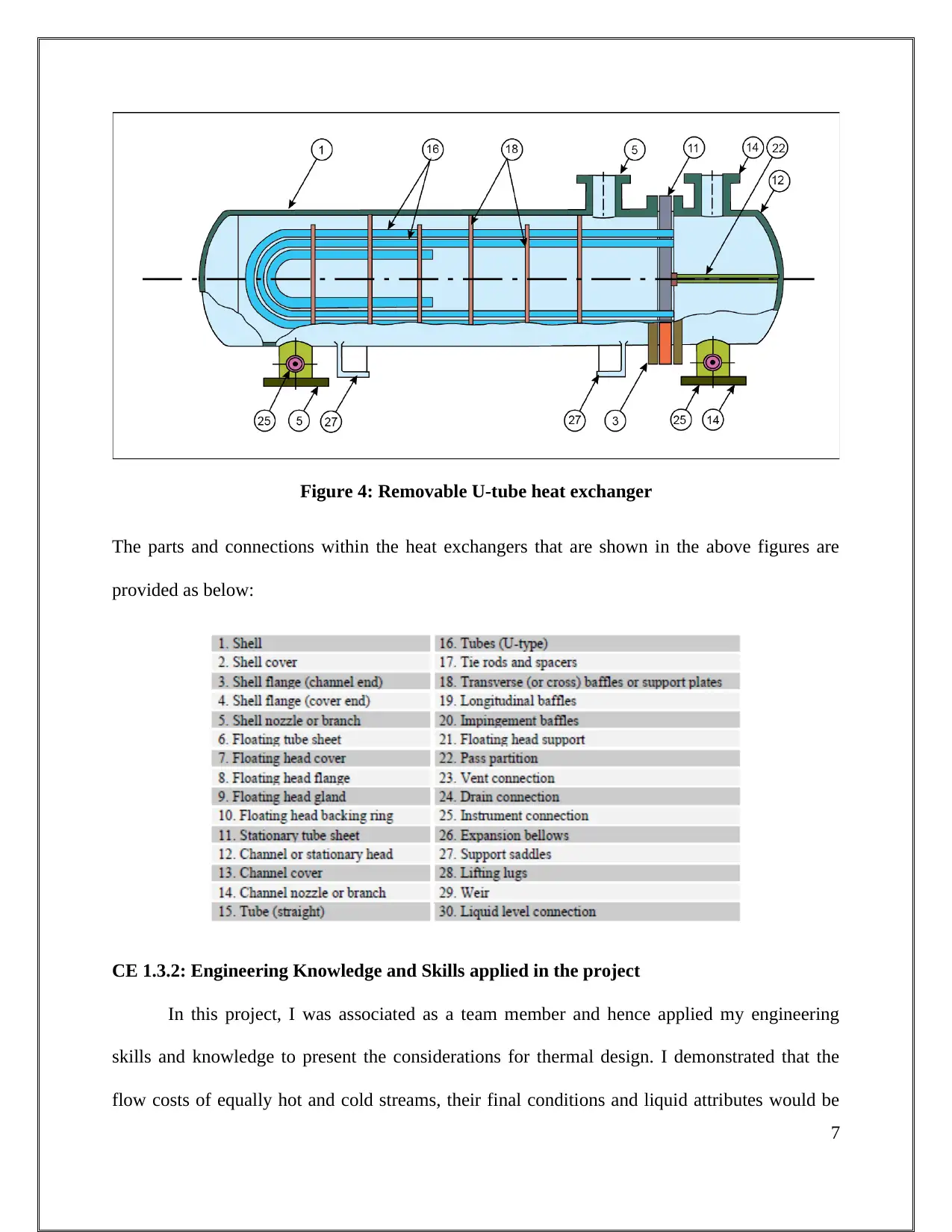
Figure 4: Removable U-tube heat exchanger
The parts and connections within the heat exchangers that are shown in the above figures are
provided as below:
CE 1.3.2: Engineering Knowledge and Skills applied in the project
In this project, I was associated as a team member and hence applied my engineering
skills and knowledge to present the considerations for thermal design. I demonstrated that the
flow costs of equally hot and cold streams, their final conditions and liquid attributes would be
7
The parts and connections within the heat exchangers that are shown in the above figures are
provided as below:
CE 1.3.2: Engineering Knowledge and Skills applied in the project
In this project, I was associated as a team member and hence applied my engineering
skills and knowledge to present the considerations for thermal design. I demonstrated that the
flow costs of equally hot and cold streams, their final conditions and liquid attributes would be
7
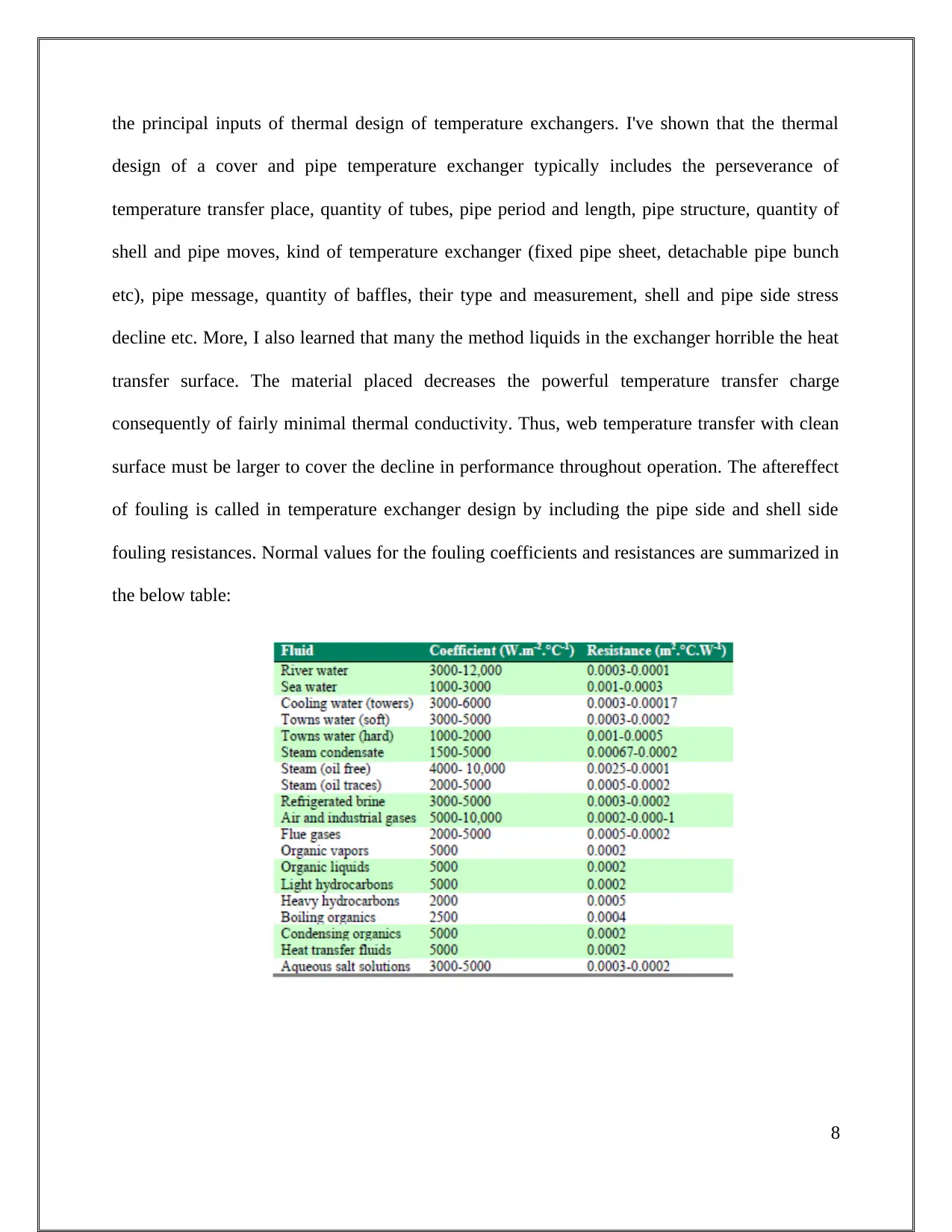
the principal inputs of thermal design of temperature exchangers. I've shown that the thermal
design of a cover and pipe temperature exchanger typically includes the perseverance of
temperature transfer place, quantity of tubes, pipe period and length, pipe structure, quantity of
shell and pipe moves, kind of temperature exchanger (fixed pipe sheet, detachable pipe bunch
etc), pipe message, quantity of baffles, their type and measurement, shell and pipe side stress
decline etc. More, I also learned that many the method liquids in the exchanger horrible the heat
transfer surface. The material placed decreases the powerful temperature transfer charge
consequently of fairly minimal thermal conductivity. Thus, web temperature transfer with clean
surface must be larger to cover the decline in performance throughout operation. The aftereffect
of fouling is called in temperature exchanger design by including the pipe side and shell side
fouling resistances. Normal values for the fouling coefficients and resistances are summarized in
the below table:
8
design of a cover and pipe temperature exchanger typically includes the perseverance of
temperature transfer place, quantity of tubes, pipe period and length, pipe structure, quantity of
shell and pipe moves, kind of temperature exchanger (fixed pipe sheet, detachable pipe bunch
etc), pipe message, quantity of baffles, their type and measurement, shell and pipe side stress
decline etc. More, I also learned that many the method liquids in the exchanger horrible the heat
transfer surface. The material placed decreases the powerful temperature transfer charge
consequently of fairly minimal thermal conductivity. Thus, web temperature transfer with clean
surface must be larger to cover the decline in performance throughout operation. The aftereffect
of fouling is called in temperature exchanger design by including the pipe side and shell side
fouling resistances. Normal values for the fouling coefficients and resistances are summarized in
the below table:
8
⊘ This is a preview!⊘
Do you want full access?
Subscribe today to unlock all pages.

Trusted by 1+ million students worldwide
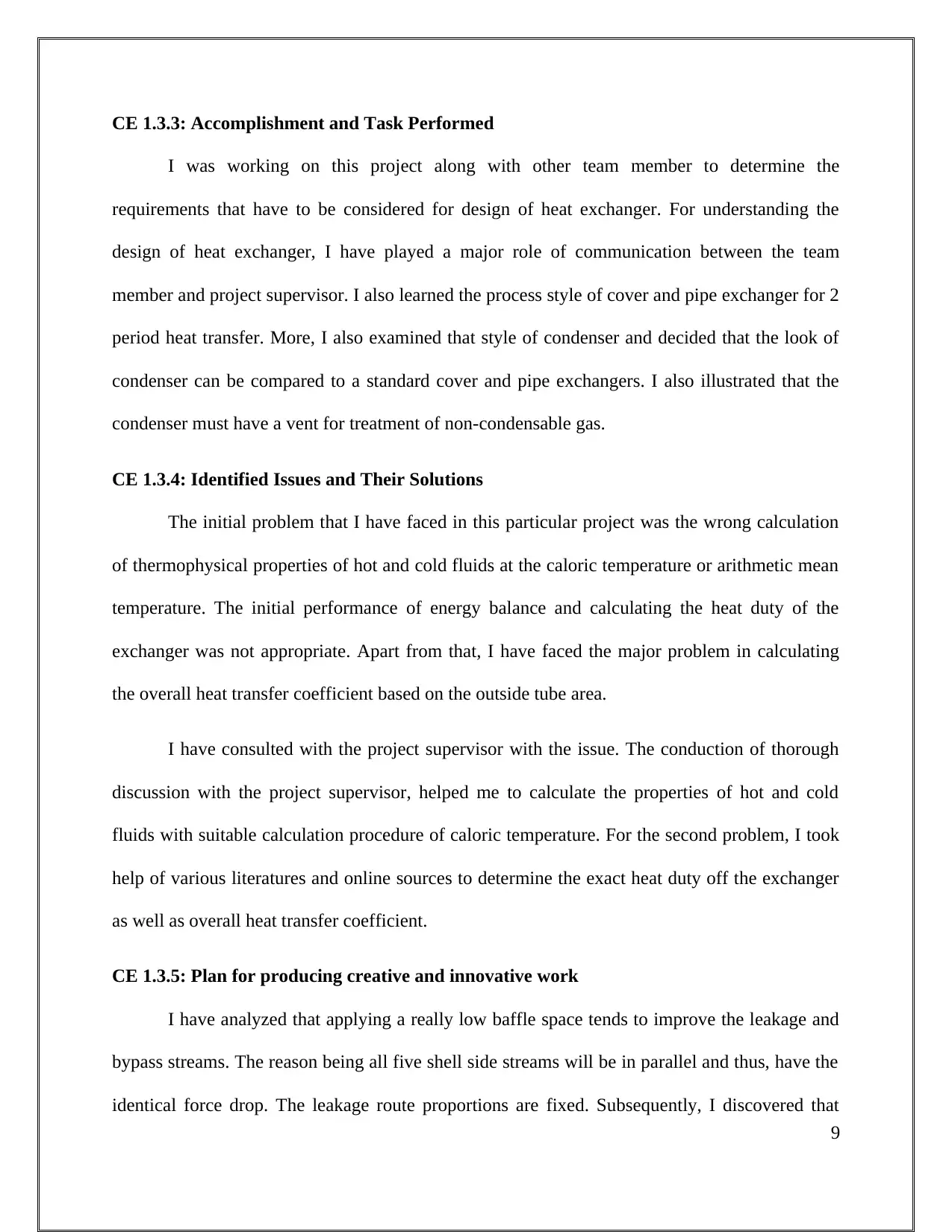
CE 1.3.3: Accomplishment and Task Performed
I was working on this project along with other team member to determine the
requirements that have to be considered for design of heat exchanger. For understanding the
design of heat exchanger, I have played a major role of communication between the team
member and project supervisor. I also learned the process style of cover and pipe exchanger for 2
period heat transfer. More, I also examined that style of condenser and decided that the look of
condenser can be compared to a standard cover and pipe exchangers. I also illustrated that the
condenser must have a vent for treatment of non-condensable gas.
CE 1.3.4: Identified Issues and Their Solutions
The initial problem that I have faced in this particular project was the wrong calculation
of thermophysical properties of hot and cold fluids at the caloric temperature or arithmetic mean
temperature. The initial performance of energy balance and calculating the heat duty of the
exchanger was not appropriate. Apart from that, I have faced the major problem in calculating
the overall heat transfer coefficient based on the outside tube area.
I have consulted with the project supervisor with the issue. The conduction of thorough
discussion with the project supervisor, helped me to calculate the properties of hot and cold
fluids with suitable calculation procedure of caloric temperature. For the second problem, I took
help of various literatures and online sources to determine the exact heat duty off the exchanger
as well as overall heat transfer coefficient.
CE 1.3.5: Plan for producing creative and innovative work
I have analyzed that applying a really low baffle space tends to improve the leakage and
bypass streams. The reason being all five shell side streams will be in parallel and thus, have the
identical force drop. The leakage route proportions are fixed. Subsequently, I discovered that
9
I was working on this project along with other team member to determine the
requirements that have to be considered for design of heat exchanger. For understanding the
design of heat exchanger, I have played a major role of communication between the team
member and project supervisor. I also learned the process style of cover and pipe exchanger for 2
period heat transfer. More, I also examined that style of condenser and decided that the look of
condenser can be compared to a standard cover and pipe exchangers. I also illustrated that the
condenser must have a vent for treatment of non-condensable gas.
CE 1.3.4: Identified Issues and Their Solutions
The initial problem that I have faced in this particular project was the wrong calculation
of thermophysical properties of hot and cold fluids at the caloric temperature or arithmetic mean
temperature. The initial performance of energy balance and calculating the heat duty of the
exchanger was not appropriate. Apart from that, I have faced the major problem in calculating
the overall heat transfer coefficient based on the outside tube area.
I have consulted with the project supervisor with the issue. The conduction of thorough
discussion with the project supervisor, helped me to calculate the properties of hot and cold
fluids with suitable calculation procedure of caloric temperature. For the second problem, I took
help of various literatures and online sources to determine the exact heat duty off the exchanger
as well as overall heat transfer coefficient.
CE 1.3.5: Plan for producing creative and innovative work
I have analyzed that applying a really low baffle space tends to improve the leakage and
bypass streams. The reason being all five shell side streams will be in parallel and thus, have the
identical force drop. The leakage route proportions are fixed. Subsequently, I discovered that
9
Paraphrase This Document
Need a fresh take? Get an instant paraphrase of this document with our AI Paraphraser
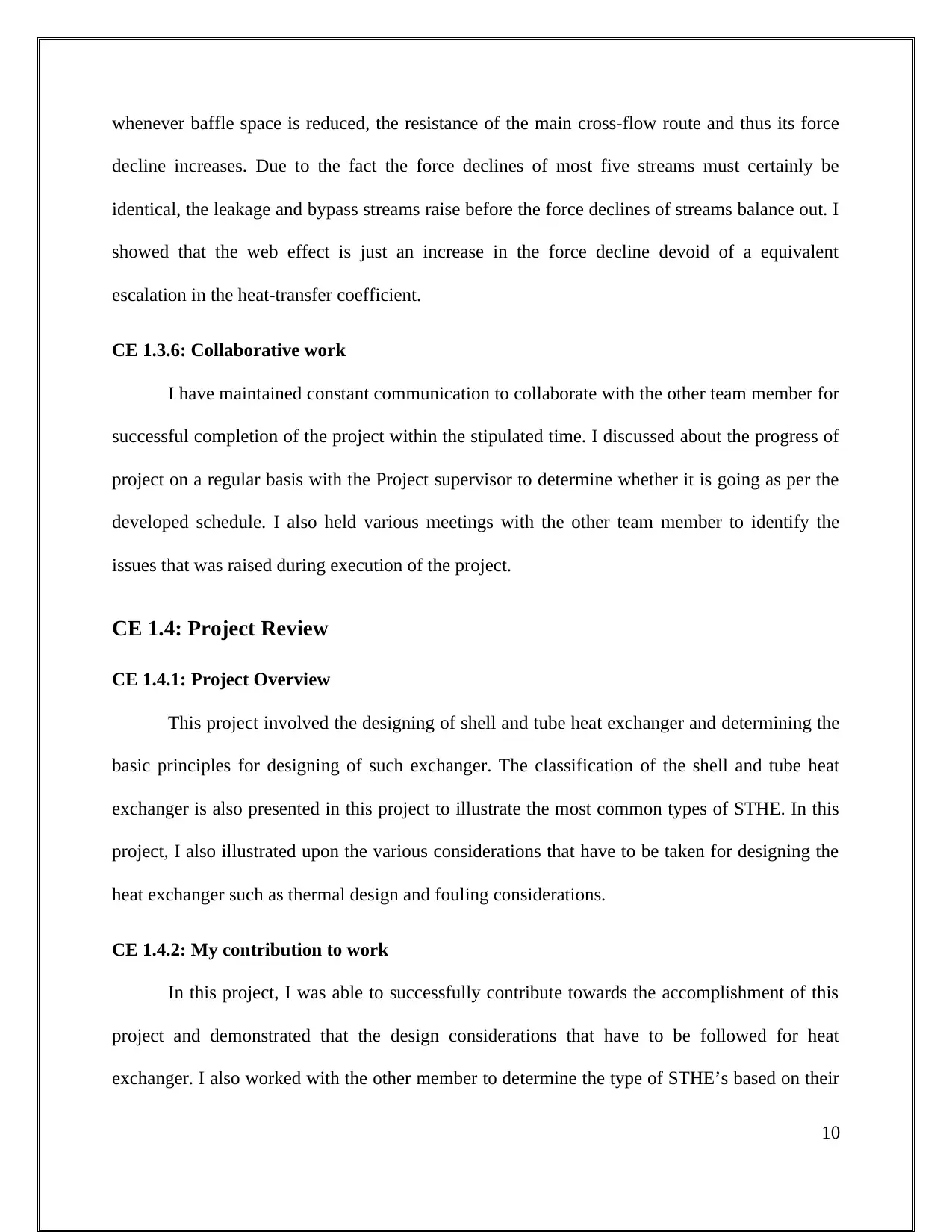
whenever baffle space is reduced, the resistance of the main cross-flow route and thus its force
decline increases. Due to the fact the force declines of most five streams must certainly be
identical, the leakage and bypass streams raise before the force declines of streams balance out. I
showed that the web effect is just an increase in the force decline devoid of a equivalent
escalation in the heat-transfer coefficient.
CE 1.3.6: Collaborative work
I have maintained constant communication to collaborate with the other team member for
successful completion of the project within the stipulated time. I discussed about the progress of
project on a regular basis with the Project supervisor to determine whether it is going as per the
developed schedule. I also held various meetings with the other team member to identify the
issues that was raised during execution of the project.
CE 1.4: Project Review
CE 1.4.1: Project Overview
This project involved the designing of shell and tube heat exchanger and determining the
basic principles for designing of such exchanger. The classification of the shell and tube heat
exchanger is also presented in this project to illustrate the most common types of STHE. In this
project, I also illustrated upon the various considerations that have to be taken for designing the
heat exchanger such as thermal design and fouling considerations.
CE 1.4.2: My contribution to work
In this project, I was able to successfully contribute towards the accomplishment of this
project and demonstrated that the design considerations that have to be followed for heat
exchanger. I also worked with the other member to determine the type of STHE’s based on their
10
decline increases. Due to the fact the force declines of most five streams must certainly be
identical, the leakage and bypass streams raise before the force declines of streams balance out. I
showed that the web effect is just an increase in the force decline devoid of a equivalent
escalation in the heat-transfer coefficient.
CE 1.3.6: Collaborative work
I have maintained constant communication to collaborate with the other team member for
successful completion of the project within the stipulated time. I discussed about the progress of
project on a regular basis with the Project supervisor to determine whether it is going as per the
developed schedule. I also held various meetings with the other team member to identify the
issues that was raised during execution of the project.
CE 1.4: Project Review
CE 1.4.1: Project Overview
This project involved the designing of shell and tube heat exchanger and determining the
basic principles for designing of such exchanger. The classification of the shell and tube heat
exchanger is also presented in this project to illustrate the most common types of STHE. In this
project, I also illustrated upon the various considerations that have to be taken for designing the
heat exchanger such as thermal design and fouling considerations.
CE 1.4.2: My contribution to work
In this project, I was able to successfully contribute towards the accomplishment of this
project and demonstrated that the design considerations that have to be followed for heat
exchanger. I also worked with the other member to determine the type of STHE’s based on their
10
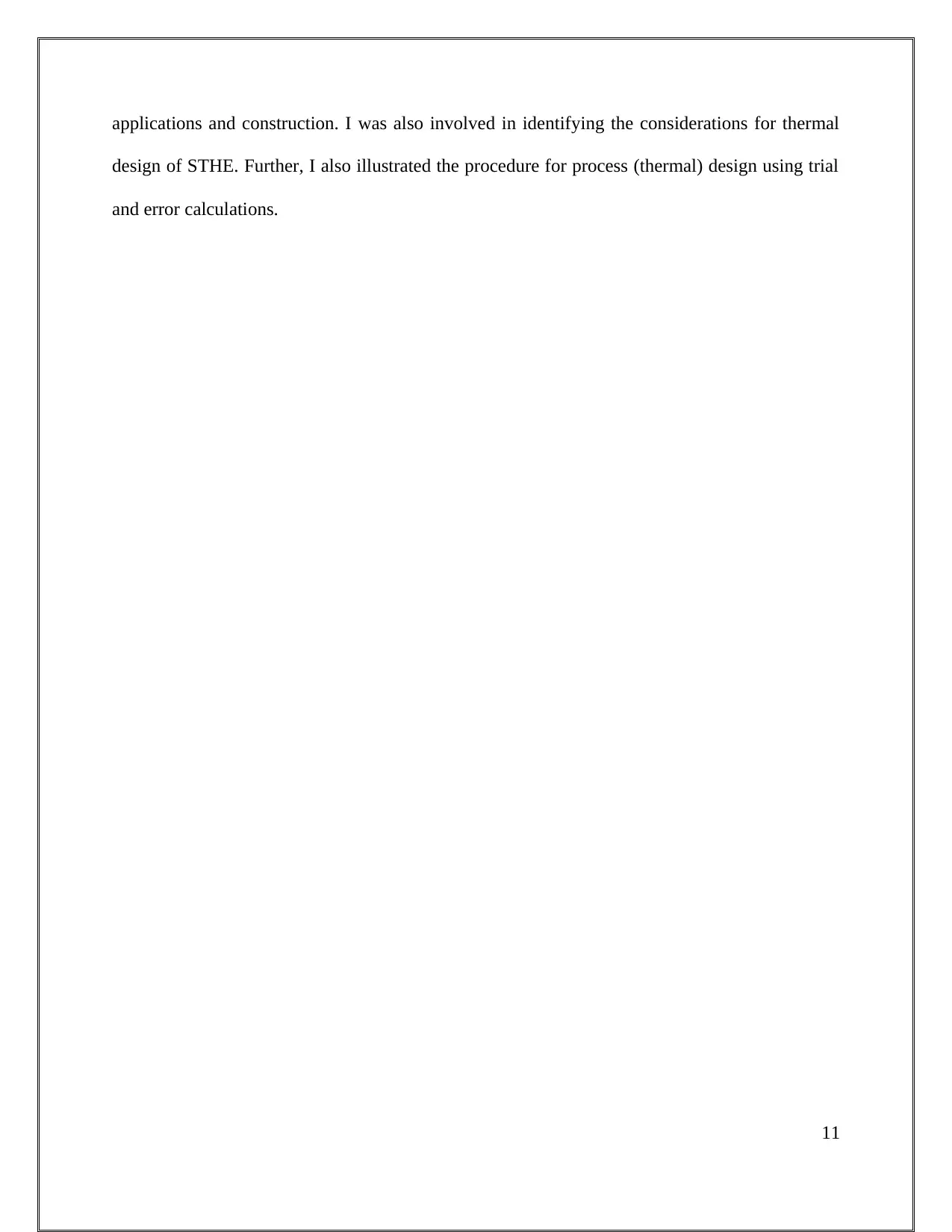
applications and construction. I was also involved in identifying the considerations for thermal
design of STHE. Further, I also illustrated the procedure for process (thermal) design using trial
and error calculations.
11
design of STHE. Further, I also illustrated the procedure for process (thermal) design using trial
and error calculations.
11
⊘ This is a preview!⊘
Do you want full access?
Subscribe today to unlock all pages.

Trusted by 1+ million students worldwide
1 out of 12
Related Documents
Your All-in-One AI-Powered Toolkit for Academic Success.
+13062052269
info@desklib.com
Available 24*7 on WhatsApp / Email
![[object Object]](/_next/static/media/star-bottom.7253800d.svg)
Unlock your academic potential
Copyright © 2020–2025 A2Z Services. All Rights Reserved. Developed and managed by ZUCOL.





